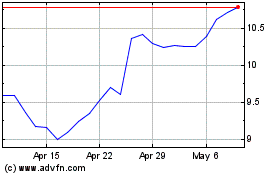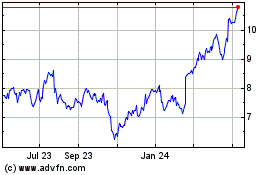New York Banking Regulator to Publish New Rules to Fight Money Laundering -- Update
June 29 2016 - 10:16PM
Dow Jones News
By Christopher M. Matthews
New York's top banking regulator is set to publish on Thursday
strict and long-awaited anti-money-laundering regulations to take
effect in 2017.
The new regulations, reviewed by The Wall Street Journal, add
stringent requirements for banks to curb illegal transactions by
known terror organizations and other criminals.
Among the more notable changes: a requirement that either board
officers or senior compliance officers certify that companies'
controls are adequate, potentially opening such individuals up to
criminal liability if the controls are found lacking.
The Department of Financial Services, which regulates New
York-chartered banks -- including Goldman Sachs Group and major
foreign banks including Deutsche Bank AG, Barclays PLC and others
-- has emerged as an aggressive pursuer of financial crime in
recent years. Maria Vullo, the agency's recently confirmed
superintendent, has said she plans to continue the tough
enforcement policies of her predecessor, Benjamin Lawsky.
"Management must set the tone of compliance from the top so that
message is disseminated throughout the enterprise," Ms. Vullo said.
"With this new regulation, New York will lead both in the fight
against terrorist financing and money laundering and in providing
useful guidance to our regulated institutions."
The new regulations, which Mr. Lawsky announced last year, would
require banks to maintain stringent electronic filters to flag
suspicious transactions that violate U.S. economic sanctions and
other rules or else face penalties from the office.
Other regulations already in place impose similar requirements,
but the New York rules, which go into effect Jan. 1, go further by
requiring banks to submit annually a board resolution or a finding
from a senior compliance officer confirming the institution is in
compliance with the regulations.
Such a requirement could open board members or compliance
officers up to a regulatory penalty or criminal prosecution, if it
is later determined their certification was false. The first
certification to the department will be due in April 2018,
according to the regulations, and banks are required to retain up
to five years of documents related to the certification.
New York Gov. Andrew Cuomo proposed a version of the regulations
in December that would have required a compliance officer to attest
to the controls' adequacy but didn't offer the option for the board
to do so instead. Banks and other interested parties had 45 days to
weigh in on the proposed regulations.
After listening to the comments, the department reworked the
regulations to include the board-certification option.
Other than that change, the final version that will be released
Thursday largely mirrors the December proposal.
The new regulations could give the New York agency greater
leeway to pursue money-laundering cases than some other federal
banking regulators, such as the Office of the Comptroller of the
Currency and the Federal Reserve Bank of New York.
The regulations also would require that banks regularly test and
update filters based on a risk assessment of the institution and
ensure they provide enough funding and hire qualified personnel to
meet the requirements of the regulations.
As well, the regulations allow the department to inspect
documentation related to anti-money-laundering controls and extract
penalties if it finds shortcomings.
Write to Christopher M. Matthews at
christopher.matthews@wsj.com
(END) Dow Jones Newswires
June 29, 2016 22:01 ET (02:01 GMT)
Copyright (c) 2016 Dow Jones & Company, Inc.
Barclays (NYSE:BCS)
Historical Stock Chart
From Mar 2024 to Apr 2024

Barclays (NYSE:BCS)
Historical Stock Chart
From Apr 2023 to Apr 2024
